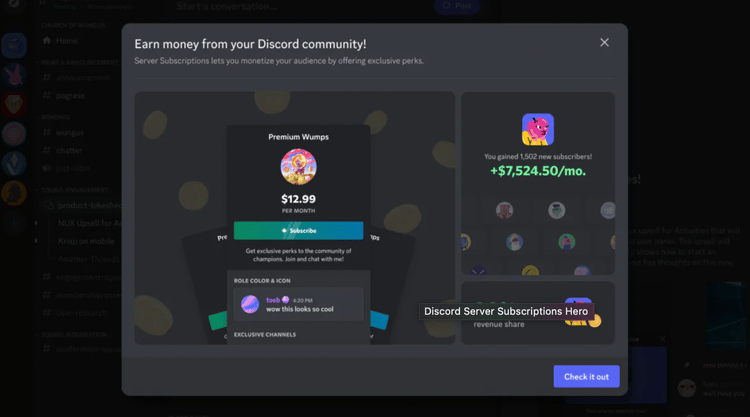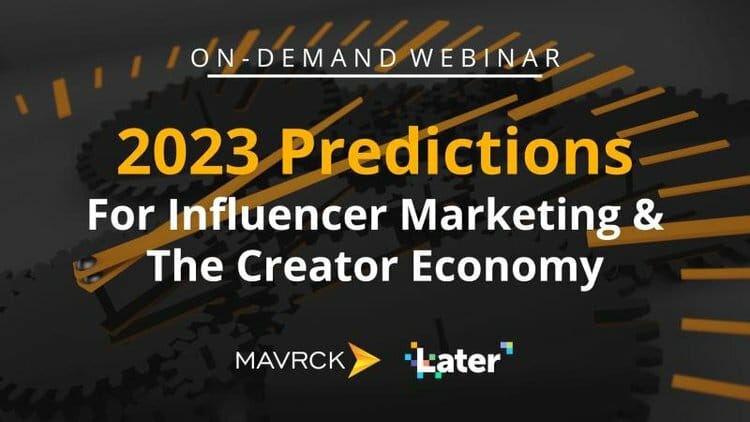You've probably read the news by now, but TikTok could be facing a potential ban in the United States. A new bill was introduced this week that would "block and prohibit all transactions" in the U.S. by social media companies with at least one million monthly users if the companies are based in countries like China, Russia, and Iran, which are considered foreign adversaries.
Considering how much money is involved with TikTok, I don't think this will happen, but creators and brands will certainly take notice. Like last time when TikTok was facing a ban, we will see creators lean into other platforms, and some brands will halt their TikTok efforts to see how things play out. This will be good news for Instagram and YouTube and their respective short-form video features in Reels and Shorts. They should see more action from both creators and brands.
Today’s Edition:
The SEC charges influencers in an alleged $100M “pump and dump” scheme
Instagram announces a handful of new features
Discord rolls out its first creator monetization feature to all creators
The SEC Charges Influencers In An Alleged $100M “Pump & Dump” Scheme

Earlier this week, the Securities and Exchange Commission (SEC) announced charges against seven financial influencers in a $100 million securities fraud.
What Happened
According to the SEC, the influencers used Twitter and Discord to manipulate exchange-traded stocks. They purchased certain stocks and then encouraged their hundreds of thousands of followers and subscribers across Twitter, Discord, and YouTube to do the same. However, they would then sell the stocks when prices and trading volume were up but often didn't disclose that they were dumping the securities. They also flaunted their flashy lifestyles. An eighth influencer was charged with aiding and abetting the alleged scheme by co-hosting podcasts with the others and positioning them as financial experts.
The Ugly Side Of Influencers
It hasn't been a good year for financial services and influencers. Earlier this fall, Kim Kardashian was charged by the SEC for unlawfully promoting a cryptocurrency. Then, at the beginning of November, influencers and celebrities who partnered with crypto exchange FTX faced backlash from their communities following its collapse.
These reveal the ugly side of influencers. While influencers can help entertain, educate, and inform for good, their power can also be harmful. This is especially true regarding industries like finance and health. As in this scenario, these creators misused their influence and misled their community, who looked at them as individuals looking to help.
More situations will likely happen as more people gravitate to social media personalities and see them as experts. It won't always be as detrimental as people losing significant amounts of money like this. But even an influencer recommending a product and their followers buying it and realizing its poor quality can lead to mistrust. The more this happens over time, the more people will be wary of taking recommendations or advice from the people they follow.
What It Means Going Forward
Influencers aren't going anywhere, but we're at an inflection point. Followers of influencers need to be careful about where and who they get information and advice from, particularly when it comes to things related to industries that often require certification or qualification to operate formally.
Also, social media platforms or even U.S. governing bodies must seek ways to protect their users, especially younger generations, who trust their favorite influencers more than traditional outlets. The great thing about social media is that it democratizes information and makes it more accessible, but with that comes a lot of risks.
Possible Solutions
Some ways to minimize that risk could be implementing certification programs to help users identify authoritative sources, like YouTube's healthcare certification program, and requiring creators to demonstrate their qualifications before promoting specific products and services, which China recently implemented. However, these could be hard to enforce due to the big battle between freedom of speech and content moderation. So, in the short term, social media platforms could add more disclaimers to protect their users more effectively.
One thing for sure is that influencers are no longer under the radar. The SEC and Federal Trade Commission (FTC) look like they will be cracking down more, meaning both creators and brands must be careful.
Instagram Announces A New Handful Of New Features

This week, Instagram announced a handful of new features, and surprisingly, they weren't Reels related. Taking a short break from pushing short-form videos, these features cover messaging, Stories, collaborative content, and more.
What’s New
Notes: Users can share short posts of text and emojis (up to 60 characters) with people that follow them back or their Close Friends list. These notes appear at the top of their inbox for 24 hours, with replies as direct messages.
‘Add Yours’ Nominations: Users can invite their friends to participate in 'Add Yours' prompts through a 'Pass It On' button.
Candid Stories: Users can capture and share what they are doing in the moment using the front and back cameras based on daily notifications and add them to a multi-author story.
Group Profiles: Users can join a new profile type that lets them share content to a dedicated, shared profile with others.
Collaborative Collections: Users can save posts to a collaborative collection in groups or DMs.
Experiences To Help People Share & Connect
Instagram brings new experiences to help people share and connect with others. In many cases, they bring similar aspects to other social media platforms. For example, with Notes, users can share quick text updates like Twitter. With Candid Stories, users can share daily activities like BeReal. With Collaborative Collections, users can curate content like Pinterest Boards.
Reels Is Still A Focus
Reels remain Meta's biggest priority, but these updates address other trends and behaviors across social media, like small group interactions, community, and collaboration. These features are more geared toward the everyday user, but as we typically see, creators always find a creative way to leverage them.
Discord Rolls Out Its First Creator Monetization Feature To All Creators

Discord is expanding Server Subscriptions to all creators. Previously known as Premium Memberships, it has been in testing for the past year. With Server Subscriptions, creators can make money by charging a monthly subscription for exclusive roles, perks, and benefits.
How Server Subscriptions Work
Creators can decide how they set up their Server Subscriptions. They can price subscriptions from $2.99 to $199.99 and will keep 90% of revenue after applicable deductions. To be eligible, creators must be U.S. based, their server must be in good standing with Discord, and they must agree to Discord's updated Monetization Terms and Server Subscriptions Policy.
Once creators have set up Server Subscriptions, they can create a Promo Page, which is a custom landing page that they can use to promote and share their subscription offerings outside of Discord.
Discord also launched Creator Portal, a one-stop destination for creators to learn. With courses from creators like Marques Brownlee, HannahxxRose, and ChefPK, interactive resources, case studies, and more, creators can learn how to best leverage Discord's features and tools, including Server Subscriptions.
What It Means For Creators
The rollout of Server Subscriptions is excellent news for creators. At a 90/10 split in favor of creators, this is one of the most creator-friendly revenue shares across social media platforms and other platforms like Patreon. The favorable split is well-deserved as it takes quite a bit of work for creators to manage Discord communities, whether acting as moderators themselves or hiring a team of moderators.
Discord creators often use third-party services like Patreon to build subscriptions into their services. But, now, with a native feature, creators have the luxury of managing subscriptions directly within Discord, making it a much more seamless experience and allowing them to make more customized subscription tiers.
With creators becoming more community-oriented, platforms like Discord allow them to build community easily and monetize will grow in popularity.
On The Blog
Amazon launched Inspire, a new in-app personalized shopping experience that delivers a TikTok-like feed featuring shoppable content from creators and brands based on users' selected interests and engagement.
Instagram updated ‘Account Status’ so creators can see whether their content is eligible to appear in recommendations like Explore.
Klarna expanded its Creator Platform to more regions, allowing retail partners to collaborate with over 500,000 creators on affiliate partnerships, brand campaigns, and gifting programs.
Mavrck & Later: 2023 Predictions For Influencer Marketing & The Creator Economy

In last week’s newsletter, I shared my big bets for the creator economy in 2023. But, I also recently was a panelist for Mavrck's 2023 predictions for influencer marketing and the creator economy on-demand webinar, where we teamed up with our friends at Later. If you're interested in hearing more about what's in store for creators, brands, and social media in the new year, watch the on-demand webinar and then download the guide.
What I’m Reading
US lawmakers introduce bill to ban TikTok (CNN)
Instagram is the new business card for creators (Business Insider)
Here are the hidden costs of being a creator (Digiday)
YouTube stars cash in video rights for millions of dollars (The Wall Street Journal)
